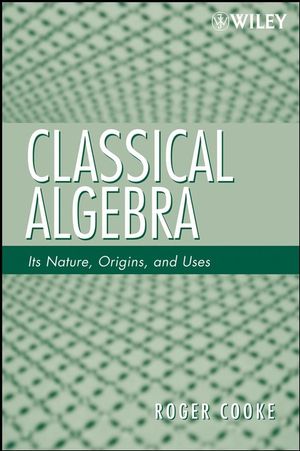Classical Algebra: Its Nature, Origins, and UsesISBN: 978-0-470-25952-8
Paperback
224 pages
March 2008
 This is a Print-on-Demand title. It will be printed specifically to fill your order. Please allow an additional 10-15 days delivery time. The book is not returnable.
|
||||||
Preface ix
Part 1. Numbers and Equations 1
Lesson 1. What Algebra Is 3
1. Numbers in disguise 3
1.1. Classical and modern algebra 5
2. Arithmetic and algebra 7
3. The environment of algebra: Number systems 8
4. Important concepts and principles in this lesson 11
5. Problems and questions 12
6. Further reading 15
Lesson 2. Equations and Their Solutions 17
1. Polynomial equations, coefficients, and roots 17
1.1. Geometric interpretations 18
2. The classification of equations 19
2.1. Diophantine equations 20
3. Numerical and formulaic approaches to equations 20
3.1. The numerical approach 21
3.2. The formulaic approach 21
4. Important concepts and principles in this lesson 23
5. Problems and questions 23
6. Further reading 24
Lesson 3. Where Algebra Comes From 25
1. An Egyptian problem 25
2. A Mesopotamian problem 26
3. A Chinese problem 26
4. An Arabic problem 27
5. A Japanese problem 28
6. Problems and questions 29
7. Further reading 30
Lesson 4. Why Algebra Is Important 33
1. Example: An ideal pendulum 35
2. Problems and questions 38
3. Further reading 44
Lesson 5. Numerical Solution of Equations 45
1. A simple but crude method 45
2. Ancient Chinese methods of calculating 46
2.1. A linear problem in three unknowns 47
3. Systems of linear equations 48
4. Polynomial equations 49
4.1. Noninteger solutions 50
5. The cubic equation 51
6. Problems and questions 52
7. Further reading 53
Part 2. The Formulaic Approach to Equations 55
Lesson 6. Combinatoric Solutions I: Quadratic Equations 57
1. Why not set up tables of solutions? 57
2. The quadratic formula 60
3. Problems and questions 61
4. Further reading 62
Lesson 7. Combinatoric Solutions II: Cubic Equations 63
1. Reduction from four parameters to one 63
2. Graphical solutions of cubic equations 64
3. Efforts to find a cubic formula 65
3.1. Cube roots of complex numbers 67
4. Alternative forms of the cubic formula 68
5. The “irreducible case” 69
5.1. Imaginary numbers 70
6. Problems and questions 71
7. Further reading 72
Part 3. Resolvents 73
Lesson 8. From Combinatorics to Resolvents 75
1. Solution of the irreducible case using complex numbers 76
2. The quartic equation 77
3. Viète's solution of the irreducible case of the cubic 78
3.1. Comparison of the Viète and Cardano solutions 79
4. The Tschirnhaus solution of the cubic equation 80
5. Lagrange's reflections on the cubic equation 82
5.1. The cubic formula in terms of the roots 83
5.2. A test case: The quartic 84
6. Problems and questions 85
7. Further reading 88
Lesson 9. The Search for Resolvents 91
1. Coefficients and roots 92
2. A unified approach to equations of all degrees 92
2.1. A resolvent for the cubic equation 93
3. A resolvent for the general quartic equation 93
4. The state of polynomial algebra in 1770 95
4.1. Seeking a resolvent for the quantic 97
5. Permutations enter algebra 98
6. Permutations of the variables in a function 98
6.1. Two-valued functions 100
7. Problems and questions 101
8. Further reading 105
Part 4. Abstract Algebra 107
Lesson 10. Existence and Constructibility of Roots 109
1. Proof that the complex numbers are algebraically closed 109
2. Solution by radicals: General considerations 112
2.1. The quadratic formula 112
2.2. The cubic formula 116
2.3. Algebraic functions and algebraic formulas 118
3. Abel's proof 119
3.1. Taking the formula apart 120
3.2. The last step in the proof 121
3.3. The verdict on Abel's proof 121
4. Problems and questions 122
5. Further reading 122
Lesson 11. The Breakthrough: Galois Theory 125
1. An example of a solving an equation by radicals 126
2. Field automorphisms and permutations of roots 127
2.1. Subgroups and cosets 129
2.2. Normal subgroups and quotient groups 129
2.3. Further analysis of the cubic equation 130
2.4. Why the cubic formula must have the form it does 131
2.5. Why the roots of unity are important 132
2.6. The birth of Galois theory 133
3. A sketch of Galois theory 135
4. Solution by radicals 136
4.1. Abel's theorem 137
5. Some simple examples for practice 138
6. The story of polynomial algebra: a recap 146
7. Problems and questions 147
8. Further reading 149
Epilogue: Modern Algebra 151
1. Groups 151
2. Rings 154
2.1. Associative rings 154
2.2. Lie rings 155
2.3. Special classes of rings 156
3. Division rings and fields 156
4. Vector spaces and related structures 156
4.1. Modules 157
4.2. Algebras 158
5. Conclusion 158
Appendix: Some Facts about Polynomials 161
Answers to the Problems and Questions 167
Subject Index 197
Name Index 205



